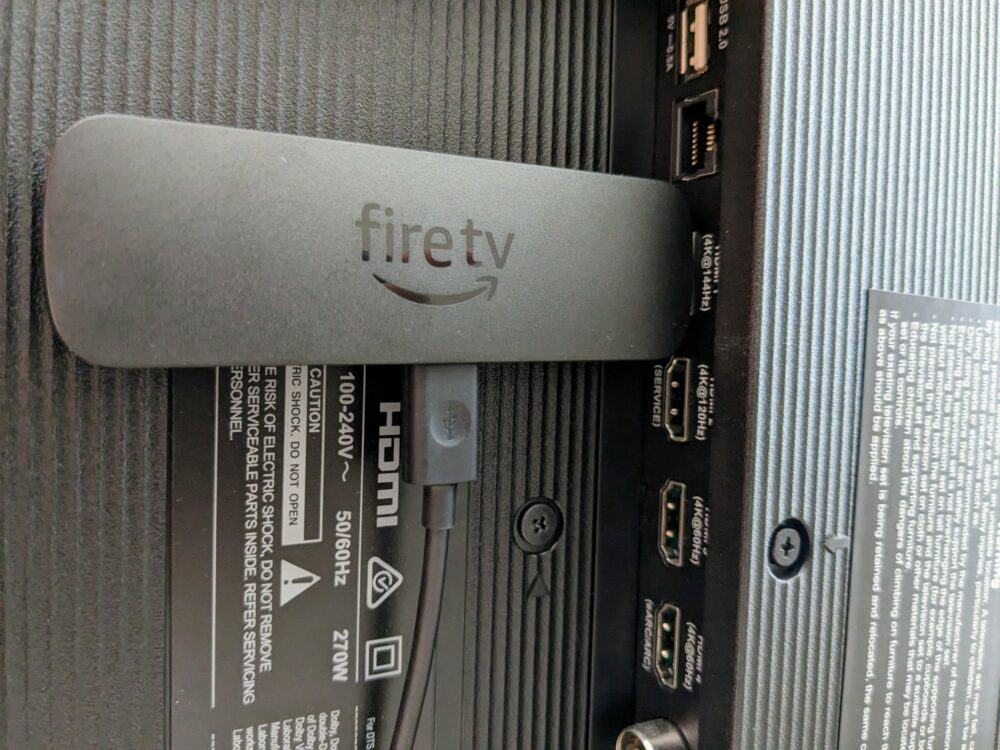Can You Use the Amazon Fire TV Stick While Traveling?
We may earn a commission from purchases you make after clicking links on this site. Learn more.The Amazon Fire TV Stick brings a wide range of streaming apps straight to your television. While it’s designed by Amazon to promote its Prime Video service, the device can stream everything from Netflix, Disney+, and Apple+ to YouTube, Spotify, live TV, and more.
But how well does it work when you’re on the road? Does it have limitations for international travel? And is it worth the extra space and weight in your carry-on when you’re on the move?
I use a Fire TV Stick on two different TVs in my home, and over the past few years, I’ve taken them with me on the road with varying degrees of success. Below is my experience using an Amazon Fire TV Stick while traveling in Airbnb’s, hotels, and motels, and the pros and cons I’ve encountered along the way.
Fire TV Stick Specifications
The Fire TV Stick plugs directly into a television’s HDMI port. It also needs power, ideally by being plugged into a wall outlet using the USB cable and power adapter that comes with the device.
The stick itself is 3.4 x 1.2 x 0.5 inches, and weighs around an ounce. The separate remote is a bit longer (5.6 inches), with a similar width and depth. It weighs a bit over two ounces with batteries installed.
The remote has a number of controls, including a navigation wheel, volume controls, mute, and app buttons for the most popular streaming services. There’s also an Alexa button, which enables voice command. It’s powered by two AAA batteries, which are included.
There’s one more piece you may or may not need, depending on the TV you’re using and how it’s set up: an HDMI extender. It comes in the box, and helps you reach the HDMI port if the TV is installed right up against a wall, with no space behind.
There’s also [Product unavailable]: as the name suggests, it upgrades the usual HD output to high-quality 4K instead. It’s a similar shape, size, and weight, but costs more: how much benefit you’ll get from it really depends on how often your accommodation has a 4K-capable TV.
The same applies to the top-of-the-line 4K Max model, which adds support for faster Wi-Fi protocols and has a fancier remote. In my experience, I’d suggest buying the more expensive versions only if you know you’ll use their extra features at home as well. If not, just go with the cheaper model.
How Well Does the Fire TV Stick Travel?

Physically, the Fire TV Stick is quite small, and so is the remote it comes with. I’m easily able to fit all the pieces inside my tech bag without having to worry about the device adding too much weight or space.
The remote requires a pair of AAA batteries, but assuming I remember to put in fresh ones before I leave on a trip, they won’t need replacing. They’ve never run out during a trip, even when I’ve been away for two months or more. I wouldn’t bother bringing extras anyway, since AAA batteries are easy to find.
For me personally, it’s compact enough to take on any trip. That said, I don’t travel with just a carry-on bag. I travel with my partner, and between us, we check one large backpack and have another carry-on for technology and other important items.
If you’re someone who needs to fit everything you own into a carry-on backpack, the Fire TV Stick and its extra charger, cables, and remote may not be worth the extra space and weight. That said, it’s a lot smaller and lighter than any tablet or laptop, if it meant you could leave them at home!
Pros and Cons
There are both pros and cons to using the Fire TV Stick while traveling, and each accommodation will be different. The device is simple to use, light to pack, and connects in seconds, but you may have difficulty physically setting it up, depending on how the TV and power outlets are situated in the room.
Pros
Cons
Can You Use a Fire TV Stick Internationally?

The short answer is yes; you can use the Amazon Fire TV Stick internationally, but there are some limitations.
I’ve attempted to use the Fire TV Stick on three separate overseas trips: to Bansko, Bulgaria, Sarandë, Albania, and Playa Del Carmen, Mexico. Dave (the editor of this site) also used one on a trip to New Zealand.
In Bansko, Playa, and New Zealand, there was no issue with connecting the Fire TV Stick and using it in various Airbnbs and holiday rentals. It connected the exact same way it did at home, with access to all of the same applications as usual.
I wasn’t able to use the Fire TV Stick in Albania, but that was due to the layout of my accommodations and a power issue, not connectivity.
Limitations came into play when accessing content on the Fire TV apps, however. Big streaming services, like Netflix, only give access to the movies and shows that are available locally.
Netflix’s streaming rights by region change all the time, so you may find you don’t have access to a show you were watching at home. If you’re crossing borders a lot, you may have access to a show in Portugal, for example, but not Spain.
Apps that are only available in Canada don’t work for me outside the country. If I wanted to access these apps, I needed to do so on my computer using a VPN. And even then it sometimes wasn’t possible, because the service detects when certain VPNs are running and refuses to work.
I know there are some technical workarounds for this, but I have an old MacBook and prefer to keep things as simple as possible. Plus, the whole point of me dragging the Fire TV Stick around is that I can stick it into the TV in seconds and have access to everything I want with a remote to control everything.
Dave experimented with using ProtonVPN on his Fire TV Stick on a trip to New Zealand, to watch live sports that weren’t being broadcast there. It’s by far his favorite VPN service, and it installed from the Amazon app store without issue. Setup only took a couple of minutes.
The sports app didn’t work at all without the VPN, but with ProtonVPN installed and connected to a server back home, the app loaded and let him tune into the game. Despite having a fast Internet connection, though, the video often buffered or stopped entirely. In the end he just gave up and used the VPN to watch the game on his laptop instead, which was much more reliable.
In reality though, even without a VPN, I’ve found that there’s absolutely enough content to watch when I’m traveling internationally between the various streaming services I subscribe to.
Any original content produced by a streaming service will be available anywhere that streaming service is available. Examples include Netflix originals like Ozark, Queer Eye, and The Witcher, or any Star Wars or Marvel show/movie available on Disney+. There’s more than enough to keep you occupied if you stick to original content.
The more streaming services continue to create their own original content, the more consistency you’ll have with what’s available internationally. Plus, beyond the original content, you may find movies and TV shows available internationally that you didn’t have access to at home or at your previous location.
You may run into issues connecting your Fire TV Stick in countries where the internet is restricted or censored. I haven’t run into this issue yet, but if you have, please let us know in the comments.
What Are the Limitations of Traveling with a Fire TV Stick?

Requires Access to an HDMI Port
As mentioned above, the Fire TV Stick needs to be plugged into the HDMI port of a television. Sometimes it’s as simple as plugging it straight into the side of the TV, but other times, you may need to use the HDMI extender.
Since the device sticks out about three inches from the TV, the extender is helpful if the HDMI port is facing the wall and there isn’t enough space to plug it in. I’ve found this to be an issue with about half the TVs I come across, so it’s definitely worth packing the extender.
On quite a few occasions though, especially in North American hotel rooms, I wasn’t able to access an HDMI port at all. Sometimes this was because the TV was mounted high up and right against the wall, or because the hotel had physically blocked access to the HDMI ports.
This happens when they have their own custom hotel media center they want you to use, and is a big pain in the you know what. I’d suggest searching through the reviews for hotels you’re thinking about staying in, just in case anyone else has mentioned this being a problem.
Requires Access to Power
Accessing power for the Fire TV Stick is often more difficult than accessing the HDMI port. The stick needs to be able to plug into both the HDMI port and a power source in order to function.
Sometimes there’s no available power source nearby in hotel and motel rooms. I’ve been in some rooms where the power cords for the TV flow down behind the furniture, and that furniture is bolted down or too heavy to move.
In other scenarios, the TV and other electronics use up all of the available outlets nearby, so you’d need a power strip of some sort to add an extra outlet. If you’re worried about this, you can sometimes tell by looking at the pictures of the TV, and where it’s placed in your Airbnb or other accommodation.
In theory you can also power the stick from one of the inbuilt USB sockets found on many televisions, but in practice it tends to be more difficult. Many of these sockets only put out 2.5W of power, and the Fire TV stick needs 5W to work reliably.
You’re unlikely to know that level of detail about a random TV in your hotel room, and most of the time even hotel staff or Airbnb owners won’t know either!
Multiple Pieces to Pack and Remember

You need to remember a few different components in order to use the Fire TV Stick: there’s the stick itself, the remote, a USB cable and power adapter, and the HDMI extender.
In the past, I’ve packed everything else I needed, only to forget the remote on my living room table. While you can use the software remote that’s built into the Fire TV app, it’s pretty slow and clunky. Without the stick or access to power, though, you definitely won’t be able to use the device.
Fortunately, I haven’t left parts of the Fire TV Stick behind at any of my accommodations yet, but it’s always a risk. If you travel with this device, make sure you check and double-check the back of the TV for the stick and cables, and nearby table tops for the remote, before you check out!
I’d recommend keeping everything together in some sort of case or pouch. In a pinch I’ve used a soft pouch that used to hold a pair of sunglasses: all of the bits (just) fitted inside, and it had the advantage of being free.
If you’re happy to spend a few dollars, a little case like this takes up a bit more room in your bag, but it protects the stick, remote, and cables from damage, and makes it much more visually obvious if you’ve left something behind.
Not All Applications Work Internationally
Your best bet for accessing streaming content internationally is to focus on international streaming providers like Netflix, Disney+, and Prime Video. Streaming services that are only available in your home country won’t be available internationally, at least not without extra work.
For example, Hulu is only available in the US, so it won’t work on the Fire TV Stick when you’re traveling internationally. Similarly, Crave is a Canadian streaming platform that only works in Canada.
That said, when a streaming service like Hulu isn’t available outside of the United States, it means that many of the other streaming providers typically pick up that content to share with international audiences. You may find that you’re able to access shows and movies on Netflix, Prime Video, or Disney+ that weren’t available at home.
Like I said above, it is possible to install VPN services like ProtonVPN from the Amazon app store, which give you a much greater chance of being able to pretend you’re still in your home country and stream the content you’re after.
They don’t always work perfectly, but are worth a try. You’ll need to use one of the paid products, though: there’s almost no chance that a free VPN will work for this.
Get regular updates from the world of travel tech and remote work
News, reviews, recommendations and more, from here and around the web
Fire TV Stick Verdict
Even though the Amazon Fire TV Stick has some limitations when traveling, when it connects, it can also be an amazing device to have with you.
It’s a great feeling to be able to walk into an Airbnb, plug the stick into the back of the TV, and instantly have access to many of your favorite streaming services and the shows you’re currently watching.
Yes, many accommodations these days have smart TVs that also let you log into and use your streaming services. Even there, though, I still use my Fire TV Stick: it means I don’t need to log into all of my apps again when I arrive, or remember to log out when I leave. It saves time and gives me peace of mind.
If you have the space in your luggage, and especially if you’ll be staying in Airbnbs as opposed to hostels, hotels, or motels, it’s well worth packing the Fire TV Stick. Just make sure you set a reminder for yourself to pack all the pieces when you leave!
Main image via Anna Quelhas/Shutterstock.com, other images via Dave Dean










One huge benefit of a Fire stick: You can access Dish if you’re a subscriber. I used to haul around an 8’ HDMI cable and run it off my laptop. Fire stick eliminates constantly damaging the cables and takes up less space.
Hmmm, so many things left unsaid. 1st off you can buy a little traveling cases for your firestick to keep everything together. 2nd use a small power strip when traveling and a long extension. 3rd use a pro VPN – I Use SurfShark and it is available in the fire app store. I use it to use BBC iPlayer which is locked to England residents only; I’m in WA state. Last go to troypoint.com (all legal info), the guy has the greatest how to and what to do guides for firesticks and other streaming devices. Enjoy!
In the past I would take my Firestick on vacation to another state and was able to watch the news Channels from my home state. Lately when traveling the Firestick picks up the news channels from the vacation states news channels instead of the home channels?
Is there a way to change this?